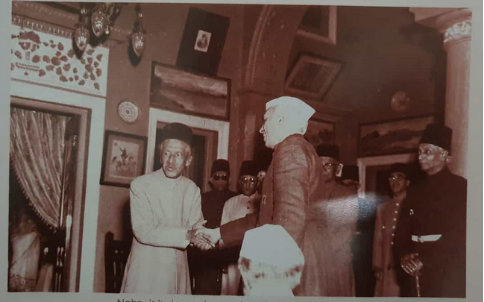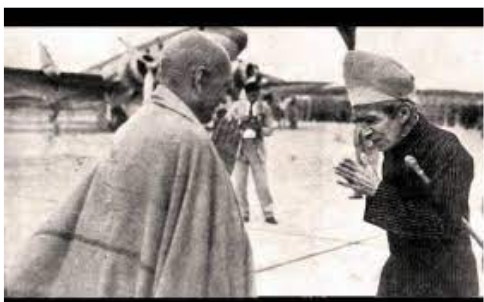- Who said Nizam was secular and great?
It is fine to boast that the last Nizam of Hyderabad got constructed this and that. But what about his autocratic and dictatorial rule? Any king would not like to keep his kingdom as a graveyard. He would add some beautiful improvements here and there and try to present his rule in glorious terms. Same was the case with the Nizam. Showing that kind of incremental developments in a magnifying mirror and giving certificates that “Our Nizam was good and great,” is not reasonable. It is the prattle indulged in those who do not know history or who do not feel the social responsibility and cannot objectively analyze the situation. If Nizam was a good king why did tribal leader Komaram Bheem revolt against him? Why did he fight? We have to think. If Nizam were great why did Shoyabullah Khan launch a verbal war against Nizam and Razakars? Why was he murdered? If Nizam were truly great, why did Chakali Ilamma revolt against his rule? Why did Congress and Communist parties fight against him? Why did Dasarathi Krishnamacharya, a great poet who wielded gun and pen in his fight against the Nizam, describing the King as the pest of the past generations? Why Yadagiri sang a revolutionary song which said the tomb for the Nizam would be built under Golkonda fort? Why did Narayana Rao Apte throw a bomb at Nizam at Abid Road? Who said Nizam was secular and great?

Why was Diwan Kishan Prasad removed?
Soon after assuming power the seventh Nizam removed Raja Kishan Parshad who was the Prime Minister during his father’s rule. Was it not because he thought a Hindu cannot be in a pivotal position? Why did the Nizam sneer, “Tu Kishan Parshad hai to mai Khuda Parshad” (meaning if you are an offering of Krishna, I am an offering of Allah)? Why did he exhibit his hatred for Hindu signs and bindi. All these things were published in Rahabare Deccan, an Urdu newspaper of those days.
Those who analyze and understand history should think about the many sacrifices made. Why are we remembering all of them with reverence? If one thought about this question, he would find the answer. If the Seventh Nizam, Osman Ali Khan, were great why would he bring a monster by name Khasim Razvi to perpetuate heinous crimes against the people here? Why did he allow his private army, Razakars, to roam about under the leadership of Razvi? We cannot even imagine the barbarities committed by the Razakars on the native people. The tax imposed by Nizam was more than the total agriculture income of the farmers. Nizam was known as one of the richest persons on the face of the earth because he looted the poor farmers of his fiefdom. However, Nizam was personally an unmitigated miser. He used to get only tea and a couple of Osmania biscuits whoever and however important was the guest.
Atrocities by Khasim Razvi and Razakars
Razakars used to collect the taxes by force under the leadership of Khasim Razvi and under the watch of the Nizam. Those who failed to pay taxes in time were subjected to all kinds of violence. They used to cut out the flesh under the nails and remove them. Women were molested in presence of their husbands and the men were hacked to death before the very eyes of their wives. If anyone fled from the place out of fear of torture, their wives and other members of the family were pressurized to give information about them. If they refuse to divulge information about the fled, the babies in the family were thrown up in the air and allowed to fall in standing swords killing them there and then. There is no evidence of anyone who saw the Razakars and survived. When the Razakars passed through villages on horsebacks, people in the village shut their doors and peeped through small holes. If anyone is seen in their path, he or she was tied to a horse and mercilessly dragged till the victim dropped dead. When we think of those days, we wonder if they were human beings. Was the Nizam who allowed them to commit atrocities on the people was human at all? One has to suspect the mental health of those who give such an unkind ruler character certificates saying he was secular and great. The atrocities by the Razakars had to be suffered by the people of Hyderabad princely state till 13 September 1948. People were threatened that they would be killed if they tried to cooperate with the union government. At that time, about 32,000 persons were hiding at Secunderabad cantonment.

Razvi’s diplomacy
Nizam, who ruled with the help of Razakars, tried his best to remain an independent ruler of a separate Hyderabad kingdom. But the Indian union did not oblige. He went to the extent of merging with the distant Pakistan (Before the formation of Bangladesh, East Pakistan was part of Pakistan). Indian leaders, especially Sardar Patel said nothing doing. Pressure was brought upon him to surrender. Nizam sent Khasim Razvi as his emissary to Delhi. Razvi tried to be clever. He threatened Sardar Patel saying that if he tried to merge Hyderabad into Indian Union the Razakars would massacre one crore people there. The Sardar did not lose his cool. The soft and peaceful way the Sardar responded frightened Razvi. Sardar said, “It appears you have only two wives and six children. But your Nizam has tens of wives and hundreds of children. We only hope they would remain safe.” A shocked Khasim Razvi had to flee from Sardar’s presence. He realized that his diplomacy had utterly failed and left Delhi.
Merger in the union
On 17 September 1948, the Hyderabad princely state was merged into the Indian Union. Because of the then Indian Prime Minister Jawaharlal Nehru’s large heartedness, the Nizam was given a status of Raj Pramukh. This was equivalent to the position of Governor. The rest of the important persons in Nizam’s dispensation had to face miserable conditions. The Diwan of the Nizam, Mir Laiq Ali Khan, realized early and went away to Pakistan. Major General Syed Ahmed El Edroos, commander-in-chief of Hyderabad State forces, spent major part of rest of his life in jail. He lived after release from prison listlessly. KM Munshi, who came to Hyderabad as India Agent, got closer to Nizam and did not pass on to the Union Government the details of atrocities committed by Razakars in Hyderabad State. He too went into the oblivion. Razakar’s chief Khasim Razvi understood late that his time was up and tried to flee but was caught by the police and put him in jail. He went to Pakistan on 17 September 1957, nine years after Hyderabad was merged in the union, after his release. He died in miserable conditions in Karachi where no one took notice of him. Indian army killed Razakars in Hyderabad as and when they were caught. Some of them were clever enough to go to Pakistan. Some of those who could not escape had their beards clean shaved and merged in the milieu of old city of Hyderabad and survived.
Telugu banned, conversions at peak
The last Nizam, Osman Ali, during his rule, banned Telugu, the mother tongue of majority of the people. People used to read Telugu newspapers by stealth. Hindus were not able to celebrate their festivals. There was ban on processions and public meetings. Poets, writers and journalists were subjected to numerous difficulties. The majority Hindus were not preferred for government jobs. Conversions used to go on unabated. Razakars licked off tilak (bindi) from Hindu foreheads. A government organization by name ‘Thablig’ used to work for conversions. Even the educated Hindus used to wear Rumi topi and sherwani as though they were de-alienated and roam about like the members of the royal family. One will know this if the old photos in Osmania University are examined. The Congress workers, members of language movement, journalists and members of Arya Samaj who questioned Nizam’s dictatorial rule and conversions were mercilessly killed. Vattikota Alwar Swamy and Dasarathi Krishnamacharya were jailed by the Nizam government. Dasarathi was the soldier who fought wielding a gun. No other poet in the world could boast of such a glorious history.
Nightmare of Nizam rule
Nizam used three kinds of forces against the people. 1. Razakars under the leadership of Khasim Razvi. 2. Nizam’s army. 3. Police. Some of those who witnessed the atrocities committed by these three forces are still around in Telangana to tell us the gory stories. They would tell us the tales of women who were forced to play Bathukamma naked and the men being killed all over Hyderabad State. I heard the dreadful stories myself from many a witness. Many who could not stand the humiliations went to Vijayawada to hide. The pages of the then Hyderabad State which were drenched in the blood of the innocent people are still wet. Some of the senior citizens who have nightmares about the miserable memories are among us. Who said Nizam was secular and great?




